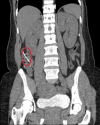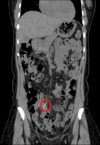Fishbone Foreign Body Ingestion With Gastric Impaction and Intestinal Micro-perforation in an Adult Female: A Case Report
- PMID: 39575044
- PMCID: PMC11581452
- DOI: 10.7759/cureus.72099
Fishbone Foreign Body Ingestion With Gastric Impaction and Intestinal Micro-perforation in an Adult Female: A Case Report
Abstract
Foreign body ingestion of fishbones is a very common complaint where most foreign bodies travel safely through the gastrointestinal tract (GIT) without any serious complications. However, its clinical presentation is nonspecific, and its clinical severity can vary widely, thus requiring the use of conservative and or invasive treatment modalities. In this case report, we present a case of a 42-year-old female who reported eating fish two days prior to presenting with upper gastrointestinal tract (GIT) foreign body impaction in addition to a lower GIT micro-perforation secondary to fishbone ingestion, both of which were successfully managed with conservative, nonsurgical treatment modalities. Impaction, perforation, or obstruction of fishbone foreign bodies often occur at GIT angulations or narrowing. Clinical diagnosis of foreign body ingestion requires the use of multiple modalities such as a detailed history, physical exam, radiographic evaluation, and endoscopic evaluation as needed. Treatment depends on multiple factors and can be conservative or surgical in nature. Fishbone foreign body ingestion is a common complaint and rarely leads to severe complications. However, its diagnosis can be difficult without an explicit history highlighting ingestion of fishbones and requires the use of appropriate imaging modalities such as computed tomography (CT) scans. Subsequent management may require conservative or invasive treatment modalities based on the location of the fishbone, and the presence or absence of accompanying complications such as peritoneal signs, sepsis, and radiographic identification of bowel perforation.
Keywords: fishbone; fishbone foreign body ingestion; fishbone impaction; fishbone injury; foreign body ingestion in adults; gastroenterology and endoscopy; lower gastrointestinal tract; micro-perforation; surgical case report; upper gastrointestinal tract.
Copyright © 2024, Dupont et al.
Conflict of interest statement
Human subjects: Consent for treatment and open access publication was obtained or waived by all participants in this study. Conflicts of interest: In compliance with the ICMJE uniform disclosure form, all authors declare the following: Payment/services info: All authors have declared that no financial support was received from any organization for the submitted work. Financial relationships: All authors have declared that they have no financial relationships at present or within the previous three years with any organizations that might have an interest in the submitted work. Other relationships: All authors have declared that there are no other relationships or activities that could appear to have influenced the submitted work.
Figures







Similar articles
-
Appendicular Perforation Caused by a Fishbone: A Case Report.Cureus. 2025 Feb 1;17(2):e78362. doi: 10.7759/cureus.78362. eCollection 2025 Feb. Cureus. 2025. PMID: 40041646 Free PMC article.
-
Multiple abdominopelvic abscesses caused by fishbone: A case report of rare etiology and literature review.Int J Surg Case Rep. 2023 Sep;110:108608. doi: 10.1016/j.ijscr.2023.108608. Epub 2023 Aug 6. Int J Surg Case Rep. 2023. PMID: 37579633 Free PMC article.
-
Removal of foreign bodies in the upper gastrointestinal tract in adults: European Society of Gastrointestinal Endoscopy (ESGE) Clinical Guideline.Endoscopy. 2016 May;48(5):489-96. doi: 10.1055/s-0042-100456. Epub 2016 Feb 10. Endoscopy. 2016. PMID: 26862844
-
Abdominal manifestations of fishbone perforation: a pictorial essay.Abdom Radiol (NY). 2017 Apr;42(4):1087-1095. doi: 10.1007/s00261-016-0939-9. Abdom Radiol (NY). 2017. PMID: 27717979 Review.
-
Bowel obstruction following ingestion of superabsorbent polymers beads: literature review.Clin Toxicol (Phila). 2022 Feb;60(2):159-167. doi: 10.1080/15563650.2021.1987452. Epub 2021 Oct 15. Clin Toxicol (Phila). 2022. PMID: 34651526 Review.
Cited by
-
Emergency Laparoscopic Removal of an Ingested Fishbone Perforating the Stomach After Endoscopy: A Case Report.Cureus. 2025 Mar 23;17(3):e81060. doi: 10.7759/cureus.81060. eCollection 2025 Mar. Cureus. 2025. PMID: 40271311 Free PMC article.
References
-
- Conservative management in two penetrating fishbone injuries: a case series and literature review. Al-Mulla AE, Al-wadani M, Alshaheen M, Al-Huzaim RA, Al-Ajmi KS. J Clin Med Res. 2021;6:1–6.
-
- Management of ingested foreign bodies and food impactions. Ikenberry SO, Jue TL, Anderson MA, et al. Gastrointest Endosc. 2011;73:1085–1091. - PubMed
-
- Clinical guidelines for imaging and reporting ingested foreign bodies. Guelfguat M, Kaplinskiy V, Reddy SH, DiPoce J. AJR Am J Roentgenol. 2014;203:37–53. - PubMed
Publication types
LinkOut - more resources
Full Text Sources
